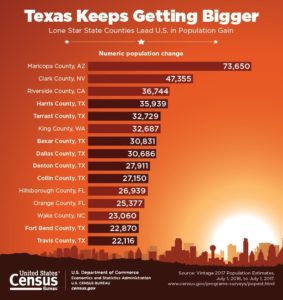The Dallas-Fort Worth-Arlington metropolitan area’s 146,000-population increase last year was the most of any metro area and Maricopa County, Ariz., saw a population increase of nearly 74,000 — the most of any county last year — according to the U.S. Census Bureau’s July 1, 2017, population estimates released today. The statistics provide population estimates and components of change for the nation’s 382 metropolitan statistical areas, 551 micropolitan statistical areas and 3,142 counties.

“Historically, the Dallas metro area attracts large numbers from both international and domestic migration. Many of the other largest metro areas in the country rely mostly on international migration and natural increase for growth,” said Molly Cromwell, a demographer at the Census Bureau.
Among the nation’s counties, the top 10 with the largest numeric growth are all located in the South and the West. The 10 largest counties in the country all maintained their rank compared to last year.
From July 1, 2016, to July 1, 2017, six of the top 10 largest-gaining counties were in Texas — Bexar, Collin, Dallas, Denton, Harris and Tarrant. The remaining four counties on the list were Maricopa County, Ariz.; Clark County, Nev.; Riverside County, Calif.; and King County, Wash. Most of the nation’s 3,142 counties grew, with 57 percent gaining in the last year.
Gaining and losing population
- Between 2016 and 2017, 1,790 counties (57.0 percent) gained population and 1,342 counties (42.7 percent) lost population. This compared to 2015-2016, when 1,655 counties (52.7 percent) gained population and 1,480 counties (47.1 percent) lost population.
- Among counties with a population of 10,000 or more in 2016 and 2017, Falls Church City, Va. (a county equivalent), was the fastest-growing county with a 5.2 percent increase, adding 715 people. The rapid growth was mostly due to an increase in net domestic migration, with 492 more people moving in than out of the area between 2016 and 2017.
- The primary driver behind the growth of the 10 fastest-growing counties, 2016-2017, was net domestic migration.
- Between 2016 and 2017, 1,907 counties (60.7 percent) experienced natural increase, meaning there were more births than deaths. This compares to 2015-2016, when 1,942 counties (61.8 percent) experienced natural increase.
- Also between 2016 and 2017, 1,200 counties (38.2 percent) experienced natural decrease, meaning more people died in the county than were born. This compares to 2015-2016 when 1,164 counties (37.0 percent) experienced natural decrease.
- Between 2016 and 2017, the number of counties that showed a positive net migration was 1,661 (52.9 percent), meaning more people moved into the county than moved out, and 1,470 (46.8 percent) counties showed negative net migration, meaning more people moved out of the county than moved into the county.
- Between 2015 and 2016, 1,469 counties (46.8 percent) showed positive net migration, and 1,660 counties (52.8 percent) showed negative net migration.
Growth
- Many of the top 10 metro areas with the largest numeric increases in 2015-2016 were also in the top 10 in 2016-2017, with the following notable exceptions: Washington-Arlington-Alexandria, DC-Va.-Md.-W.Va., climbed to 5th in 2017 from 11th in 2016, and Riverside-San Bernardino-Ontario, Calif., jumped to 7th in 2017 from 13th in 2016.
- In 2017, the Baltimore metro area was now the 20th most populous metro area, up from 21st place in 2016.
- Net domestic migration is the driving factor behind all of the top 10 fastest-growing metro areas that rose in rank — St. George, Utah; Coeur d’Alene, Idaho; Greely, Colo.; Lakeland, Fla.; and Boise, Idaho.
- Out of 382 metro areas, 87 (22.8 percent) saw population decreases between 2016 and 2017.
- The metro areas that dropped in rank within the top 10 fastest-growing metro areas, between 2016 and 2017, did so because of decreases in net domestic migration. Those areas are Bend-Redmond, Ore.; Provo-Orem, Utah; The Villages, Fla.; Cape Coral-Fort Myers, Fla.; and Austin-Round Rock, Texas.
- The St. Louis, Mo.-Ill. metro area dropped out of the top 20 most populous metro areas and swapped places with Baltimore to its new 2017 standing of the 21st most populous area in the nation. In 1960, St Louis was the 9th largest metro area.
- A decrease in net domestic migration, meaning less of a gain from movement within the United States, was the primary factor in the Tampa metro area’s drop in rank from 7th in 2016 to 10th in 2017.
- The metro area with the largest percentage decrease in population last year was Casper, Wyo., down by 1.7 percent.
- The estimates show that Puerto Rico had an estimated population of 3.3 million in 2017, a decrease from 3.4 million in 2016. Puerto Rico’s population loss is attributed to a large migration of Puerto Ricans to the mainland United States.
- All municipios in Puerto Rico decreased in population in 2015-2016 and 2016-2017.
- The municipio with the largest numeric decrease between 2016 and 2017 was San Juan Municipio (-9,246; -2.7 percent), followed by Bayamón Municipio (-4,648; -2.5 percent), and Ponce Municipio (-4,140; -2.9 percent).
- The municipio with the largest percentage decrease between 2016 and 2017 was Lares Municipio (-792; -3.0 percent), followed by Peñuelas Municipio (-628; -3.0 percent), and Guánica Municipio (-501; -3.0 percent).
Find more tables from this year’s release below.